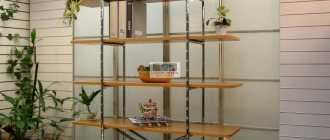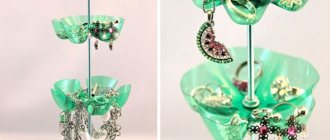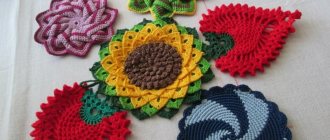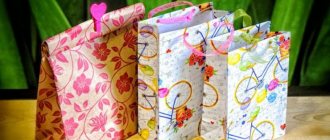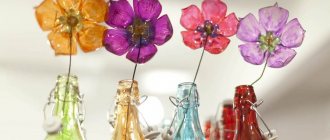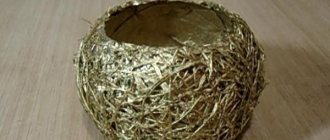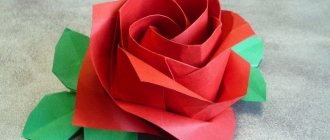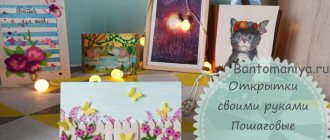If you really want, you can make a beautiful and useful thing yourself. If you love and collect boxes, then using the master classes below you will learn how to assemble boxes with lids of any size.
Crafts made from papier-mâché are so simple that even a beginner can master them if they follow step-by-step instructions. You'll also find a wide range of great decorating ideas below.
Shells, pebbles and other little things
This is a very easy-to-implement way to transform any, even the most ordinary and unattractive flower pot.
The best part is that this technology gives enormous scope for creativity and imagination: you can decorate pots in a marine style, in one color or using interesting color combinations, select decorative elements that fit perfectly with the overall style of the room, etc. Based on this simple method, you can create products that are completely different in style, texture and appearance. The technology for such decoration is very simple: you will need universal PVA glue or any other universal glue, a brush, a pot and the material with which you are going to decorate the pot. In some cases, for example, when using shells, the pot will look even more attractive if, after gluing the decor, it is coated with a colorless glossy varnish. If you have chosen large items for decoration, glue is applied to their underside and glued to the pot. In the case of small objects, it is more convenient to cover small areas of the pot with glue in order to place decorative elements on them.
If desired, the surface of the pot between the decorative elements can be primed with glue (you will get a transparent substance) or with decorative primers and putties of different colors and textures.
Planters made of branches or bamboo
Natural materials are the best way to decorate your interior, as they are naturally beautiful and environmentally friendly. One option for creating a flowerpot is a flowerpot made from reed or bamboo branches.
To do this you need to prepare:
- chopped straight branches or bamboo;
- twine;
- scissors;
- glue "Moment" transparent;
- dense coarse fabric (burlap, linen);
- plastic pot.
Operating procedure:
- Before you start tying the sticks together, they should be aligned so that the product looks aesthetically pleasing.
- Then we tie the branches together with twine along the edges (2-3 cm to the edge), pulling them tightly so that the fabric does not fall apart.
- Apply a layer of glue to the outer walls of the pot and glue burlap or linen evenly.
- We tie a cloth of sticks around the pot, and tightly tie the top and bottom parts.
- The flower pots can be additionally decorated with flowers made from twine or burlap, which will give the product a special effect.
Using old items
You can turn any old items into a flower pot, sometimes the most unexpected ones. For example, plant plants in an old salad bowl or teapot. If the product has a small crack, it doesn’t matter - it can be turned towards the wall, making it invisible.
Pots made from transparent materials, such as glasses or plastic bottles, look unusual. For decoration, light stones are poured onto the bottom, then earth. The top layer is decorated with a layer of dry sawdust.
Felt plant pots
How do you like a flower pot made from an old cosmetic bag? Or street flower pots made from bags (photo)? Agree, it's unusual. As well as products in the form of large shells, shoes, open suitcases and even jeans cut off at the knee.
Flower pots made from bags
You can even use an entire coffee table as a flowerpot, placing all kinds of plants in its open drawers. Maybe your imagination will give you more creative ideas.
DIY flower pot decor at home
You can decorate flower pots, both plastic and clay, with your own hands, using any available materials that you can even find at home, or buy specially.
To work, in addition to the pot, jar or bucket itself, you will also need sandpaper, surface degreasing liquid (solvents, white spirit, acetone, nail polish remover), glue, acrylic paints.
Suitable materials for decoration:
- beautiful fabric
- jeans
- sackcloth
- paper
- newspapers
- twine, threads
- paper napkins
- twigs from trees
- pencils
- CDs
- broken plates and cups
- eggshell
- shells
- clothespins
- buttons
- cereal
- lace and knitted napkins
- bugles
- pebbles
- nail polish
- paints
- and much more that your imagination suggests. And mine told me to use the rhinestones left over from the diamond mosaic.
Preliminary preparation
Before gluing decorative elements to the surface of the pot, it must be prepared in order to get rid of existing coatings and patterns on plastic jars, excess fat and ensure better adhesion of the material. Otherwise, this may result in cracking of the paint layer, delamination and deformation.
- Therefore, first of all, the pot needs to be cleaned, washed and dried.
- Then sand it thoroughly using sandpaper.
- Degrease the surface with any solvent.
- In most cases, it is advisable to coat it with white acrylic paint or paint of a different color to match the material being decorated.
I made a selection of the most interesting, in my opinion, photos of pot decor, which I took from freely accessible Internet sources. I didn’t do my own master classes, but only selected videos with interesting ideas.
Interestingly, many ideas and technologies are similar to those that we considered for decorating Easter eggs.
What is needed to make a paper plant pot
The main “component,” of course, is paper (newspapers, magazines, unused notebooks). Several sheets should be left whole, and the rest should be cut into small pieces of approximately 10x15 cm.
In addition to paper, for the production of flowerpots you will need:
- balloon;
- a bowl or tray with plain water;
- PVA glue;
- scissors;
- mesh for decorating flower bouquets;
- a can of gold paint.
Instead of glue, you can use paste.
Making a pot with your own hands
Naturally, you can buy a pot for creativity, and those who want to create it themselves - let's create! A purchased container for flowers may not always be the way you want it to be. A pot you create with your own hands is a unique thing that your friends won’t have. And besides, any little thing made with your own hands will be an amazing gift for friends or relatives.
Clay container. Clay is the main material from which a container for planting plants is made, so let’s start with it. Clay has always been associated with the potter's wheel, but that is long gone. We will need:
- Clay.
- Bake.
Before you start work, decide on the shape and size of the container so as not to make a mistake. The next step is to soften the clay to make it more pleasant and convenient to work with.
- Separate a small piece and roll it into a ball. Thoroughly flatten the resulting figure onto the base on which you are making the pot. You have prepared the bottom.
- Form a rope about 1 cm thick. It should surround our prepared bottom. In the same way, make several more strands to make a pot of the size you need.
- Leave the product for a couple of days for it to completely harden.
- Fire the product.
So the first option is ready. This is the easiest and most interesting way to create something unusual.
Woven pot. Another interesting option would be a pot that you weave yourself. To do this, you don’t need to have any professional skills in weaving, since everything is much simpler than you think. For this work you will need:
- Twigs.
- Sackcloth.
- Twine.
- Glue.
- A small cylinder as a base.
Before starting work, prepare the twigs. They should not be too long so as not to waste time cutting them. Prepare rods equal to the height of the cylinder. You can take a little more to cover it.
- Take some string. Tie all the finished rods of the same size together and secure with twine.
- Lubricate our base (in this case the cylinder) with glue, then glue on a small piece of burlap.
- Apply glue to the burlap in the same way, and then glue the resulting twig structure.
- You can fasten everything with twine. To achieve the most striking look, tie the resulting container with decorative ribbon. So the thing will be more extraordinary and unusual.
This pot is ideal for plants that have small and weak roots. For example, for decorative flowers.
P A N N O
We apply the mass onto plywood up to 2-3 cm thick, and as soon as the mass dries, we attach the papier-mâché to the plywood along the edge with a stapler and fill all the holes left by the stapler with the papier-mâché mass.
The entire mass dries completely, and we apply the intended design onto it using carbon paper.
I want to point out and so that you do not forget - the mass is applied layer upon layer and it does not matter whether it has dried or not and nothing, do not apply any glue on the previous layer!
And now the difficult work has begun, because you need to make a three-dimensional one from a flat drawing, raising the mass from the plane by 2-3 cm.
You must immediately decide what shape you will have flowers or animals, or what you have in mind - oval, smooth, flat, or will there be a composition to which you will apply all of the above.
I made “The Fisherwoman” in this way, which I had the imprudence not to draw, not to translate, but to sculpt right away - it was something... As a result, it barely fit on the plywood.
And the legs turned out to be a little short, then we had to tear off the legs and lengthen them.
I want to admit: this was the first panel I owned.
Here is a photo of “Rybachka”:
The mass is still semi-moist, and you adjust the pattern, smoothing it in the right places, pressing the contours with a stack.
Well, everything has dried, and now the surface needs to be made smooth as skin. Using a soft wet brush, wet the dried papier-mâché mass in small sections, leveling the surface with the stack.
Yes, this is labor-intensive work that requires a lot of patience, and not every person will do this business. But making panels is one of the easiest jobs, the most difficult job is making dolls, but I will tell you about this last, and this will be in another master class.
So. We prepare the panel for painting after complete drying. At the same time, take a look at my panel - when the mixture dries, the thinnest details can lead, unfold and even disfigure... Look very carefully at the face - eyes, eyelids, nose, lips, ears, correct everything, correct everything and do not rush to paint, because after coating With paint like acrylic, and especially oil paint, you won’t be able to fix anything, but you’ll have to rip off the paint and do it all over again, which means all over again.
You can paint with any paint that is convenient for you to work with - gouache, watercolor, acrylic or oil.
Acrylic paint is convenient because it dries quickly and does not smear after that, but it needs to work if it works as a primer and you only use light shades in the drawing, but there is a smooth transition from dark to light or vice versa from light You are unlikely to succeed in dark colors, and all because it dries right before your eyes.
It’s very good to work with gouache and watercolor, but you probably know about these paints from school. And they don’t hit the budget so hard.
But if you decide to build a work of art, then oil paints are out of the competition.
I usually work with acrylic, they dry quickly. It is convenient and not convenient...
It’s not convenient because it’s very difficult with shades, you just might not have time.
Convenient - the paint is diluted with water, but it does not smudge or wash off with water.
I WOULD LIKE TO GIVE ADVICE – DILUTE ACRYLIC PAINTS ONLY WITH WATER.
Do not use any thinners or solvents, because after coating the effect of oil paint is obtained - a film that cannot be sanded off with sandpaper, but is torn off in a thick layer.
If you think that you can beat the drying time (in the sense of having time to catch the shades), and if you really like acrylic, then God bless you!
It is easier to work with oil paints, but they take a long time to dry, but it is easier to choose a color.
After complete drying, it is advisable to coat watercolor, gouache and acrylic with colorless acrylic varnish; it is very expensive, but it dries quickly and the price is justified by the fact that it takes little and can be diluted with water, just like acrylic paints. After this varnish, the panel looks... I really like it - somehow natural, natural or something.
You can coat it with furniture varnish, either colorless or tinted, well, it’s up to you. It takes a long time to dry, two to three days, and only then can the next layer be applied.
And one more tip for such work: the best paints for working on paper, cardboard, wood, canvas, ceramics, plaster, concrete from NPP Expopribor LLC - a set of 6 colors in bottles with dispensers. All the paints are good, both pearlescent and fluorescent, and can be bought at stationery stores or “Everything for School”. The paints are expensive, but they last a long time. And while I was listing all this, the product you painted dried out.
Well, that's it, your panel is ready!
PS Although acrylic varnish dries quickly, it also takes 2-3 days for the next layer, because the previous layer (not dried layer) of acrylic varnish wraps around the brush and lies on the surface in lumps, and then it starts again... In general, then read my article first. You'll have to peel everything off again, and when it peels off, it takes all the layers of paint with it. Be careful if you don't want to repeat my mistakes. In general, my first panel was tortured for me. I told you about my mistakes - don’t make them!
Good luck to you, friends!!!
Step-by-step making of pots for indoor flowers
You can easily and simply make your own pots for indoor flowers by following the instructions:
Fold a 10 m piece of rope in half.
Fold in half again.
And fold it in half again. We try to make everything work out smoothly. One end is made from threads folded in half.
At the second end we cut the part of the rope that is folded in half. As a result, on one side you get everything with the ends of the rope, and on the other side there are kinks in the rope. It is from this edge that hanging flower pots begin to be made.
From the end of the rope where the kinks are, we form a loop. A DIY hanging flower pot will have a middle at this location.
Thread a ring through the middle
Flower pots in flowerpots are hung on such rings, so it is important that it is of good quality.
Using a short piece of rope, make a loop at the bottom and wrap the rope under the ring. We thread the lower end of this rope into a loop and tighten it, pulling out the upper end of the rope
We trim the ends evenly.
We hang the ring on the wall, cabinet or kitchen unit at eye level. Can also be attached to a stable wooden board.
We determine the height of our hanging pots with our own hands for indoor flowers. On every two ropes we make a knot in this place. All four knots should be at the same level of the rope.
We retreat down to the height of the flowerpot itself from the first knots and determine the weaving pattern. All ropes must be placed in sequence. We take one rope from one line and the second from the second, and tie knots.
From the second and third lines we also take a rope and make a knot at the same level.
From the third and fourth lines we also take a rope and make a knot. We do the same with the remaining ropes. All knots must be sequentially at the same level so that the flowers look beautiful on the wall in such a pot.
We retreat below the same distance as between the first nodes. Here we have exactly the same weaving pattern - we tie four more knots in succession.
We insert our flower pot into the middle, which we will hang on the wall for fitting. We tie all the lower ends into one knot so that the flower pot is beautifully and evenly located in our flowerpot.
We cut the ropes, leaving a small tail, so that the flowerpot turns out beautiful. You can thread wooden beads onto the ends, then the wickerwork looks even more beautiful. You can also choose decorations and accessories depending on the place where you need to hang the flower. Take a pot with your favorite indoor plant, insert it into a flowerpot made of rope (or twine) and hang it on the wall.
Paint works wonders!
You have already realized that painting is the simplest (in terms of technique, but not in terms of results!) way to give flower pots a new look. Therefore, we continue the parade of colorful dwellings for indoor plants.
Rich colors
Drips and stains are not a defect, but a design idea. That's how it should be!
Each pot will be unique
Sometimes a minimum of consumables leads to wonderful results. Look how stylish these flowerpots look, and all you need is a little paint: a little white and a little black.
Black and white - classic
Here are some more amazing ornaments that, despite their simplicity, give the pots a spectacular look. It is not necessary to depict a monogram, but if you like the idea but don’t have the skill, don’t be lazy to make a stencil.
How do you like these ideas?
The following painting method is ideal for beginners, but experienced craftsmen will not refuse it. Just try it! The process is so easy and fun that you probably won’t limit yourself to decorating just one pot.
Bitmaps will never go out of style
Only bright colors available? Wonderful! Cover the surface with the main color, and when dry, paint fruits, berries or flowers.
The drawing is simple, but looks very cute
Bright floral fantasies look very beautiful on a light background. You can reduce the number of shades, for example, depict a clearing in blue-blue or pink-burgundy tones.
Floral theme is always in demand
Another modern print is of fauna, ranging from butterflies and bugs to birds and elephants. I would probably refuse a pot with a picture of a snake or spider, giving preference to fish or elephants that are more attractive to me.
Animal world - why not?
Everything in the nursery should be special, including flower pots. For example, these are cute and funny.
Fun ideas for the nursery
If you like to draw complex patterns with lots of small details, take a look at these amazing ideas. If you want to significantly reduce the time spent decorating a pot, use ready-made stencils. They will come in handy if you are planning to decorate several flowerpots in the same style.
A stencil will help you cope with the task
An easy way to add a little pizzazz to your interior is to paint your pots with paint with glitter pigments. You can limit yourself to part of the flowerpot and decorate it completely - as you like.
Let's add some glitter
Nowadays, finding the most unusual paint is not a problem, so don’t be afraid to experiment - the result can exceed your wildest expectations! Well, if you definitely don’t like the new look of the pot, just repaint it.
Literally brilliant ideas
It is impossible to show all the colorful diversity: there are countless cute, unusual and amazing ideas. Moreover, most of the work was not carried out by professionals.
There are countless options for decorating with paint.
Therefore, leave your doubts and try!
Papier-mâché flowerpot
If the collection of flowers is large, purchasing flowerpots for each of them is quite expensive. When using improvised means, you can not only save a lot, but also get the most unusual decorative products. An original papier-mâché floor or hanging planter can complement a collection of flower pots.
Papier-mâché cups
Paper-adhesive mass is an excellent material that is easy and simple to work with.
But it is better to use a painted and varnished product for planting flowers that are not irrigated with water.
So, let's describe the process of creating papier-mâché flower pots:
1We will glue the plastic container so that moisture does not dissolve the paper over time. You can use a mayonnaise bucket.
2The container must first be degreased and then coated with a primer for better adhesion (you can use regular glue).
3First, prepare the paste. For half a liter of cold water you will need a large spoon of flour. Brew it to a boil, remembering to stir so that no lumps form.
4Tear thin paper or newspapers into pieces measuring 4x4 cm. It is not recommended to use scissors and cut them - only with your hands.
5Mix the paste thoroughly with the torn paper.
6To strengthen it, you can add wood glue to the solution. A more homogeneous mass is obtained by adding chalk to the paste.
7You can also mix the composition with gypsum, clay or sawdust.
8When using cardboard, it must be torn into smaller pieces and first soaked in plain water, and then mixed with paste. The resulting mass is first squeezed out by hand, dried and ground on a grater.
9We begin to slowly, pressing tightly, apply the solution to the jar. We don't touch the bottom.
10Our product will take several days to dry.
11Using papier-mâché, you can simply decorate any container using the decoupage technique. To do this, blanks in the form of flowers or figures are prepared from paper and glue. Then they are glued to the flower pots and varnished. The gaps between applications can be decorated with decorative paper napkins.
12 Paint the work with watercolors, gouache or acrylic. The final stage is varnishing to impart water-repellent properties.
13The flowerpot in the shape of a stump looks very original. To do this, dried papier-mâché is painted first with black paint, and then with a second layer of strokes of ocher dye.
Finished papier-mâché work
How to make a children's house with your own hands: from wood and other materials. Drawings with dimensions | (80 Photo Ideas & Videos)
Weaving from newspapers
How to make a flower pot out of newspapers? The process of creating it is similar to making flowerpots from willow branches . The only thing is that the paper must be properly prepared for work.
Preparation of blanks
To obtain strong “branches,” the newspaper must be twisted.
For this:
1The paper is cut into fairly wide strips 6-7 cm thick.
2Each strip is laid on a long knitting needle at an angle of 35-30°.
3We begin to wind the paper onto the knitting needle as tightly as possible, holding the tip of the newspaper with your finger for convenience.
4Glue the remaining edge so that we get a thin tube. One end should be slightly thicker than the other, so that in the future we can build it up by inserting one into the other. The length of the workpiece depends on the size of the future craft.
5 Remove the knitting needle from the tube and dry the glued area for 15-20 minutes.
6The resulting blanks can be immediately painted with gouache, watercolors, and acrylic paints. For these purposes, non-standard pigments are often used - for example, iodine, henna, basma, water-based wood stain, food coloring, etc. When creating patterns, ready-made products are coated with dye.
7To strengthen and protect from moisture, the finished pots are varnished. It is better to do this the first time at the preparation stage. The finished product is painted a second time.
We will not describe in detail how to weave flower pots from plastic bottles. The scheme of work is completely similar to weaving from newspapers or willow twigs.
Ready-made paper pots
Hanging flower pots are best used in rooms with sufficient light. If the room faces the shady side, it is better to grow indoor flowers on the window, where there is more light.
Methods of weaving from newspapers
A standard wicker flowerpot consists of a bottom, which is made separately, and sides. You can use any container as a form: from a bucket to a small jar.
There are many types of weaving. In difficult cases, several tubes are woven at once.
Paper weaving step by step
We'll stick to the simplest ones:
1First, you need to prepare a frame in the form of many rays emanating from the center of the bottom. For this you will need 12 tubes. They must be divided into 2 parts of 6 pieces and each of them must be secured with a clothespin.
2Fold both parts perpendicular to each other on a flat surface so that their intersection is in the center.
3Glue them together at the junction.
4Take a new tube, bend it in half and place the bend under any of the 4 crossed parts.
5 We begin to gradually braid them using the “rope” method, alternately twisting each part.
6After 2 rows have been intertwined, we begin to twist not several pieces at once, not 4, but 2 tubes at a time.
7 After a few more rows, we begin to braid each tube.
8When the bottom is ready, we begin weaving the wall. Take a suitable jar or other container and place it in the center of the bottom. To prevent the light form from moving out, it is better to fill it with something heavy, for example, stones.
9 Using a knitting needle, we make a small hole in the weaving next to the stand tube and insert a new piece of rolled newspaper into it, slightly moving the edge outward.
10The second tube must be placed under the adjacent rack.
11To prevent the rolled paper piece from breaking when bent, it is carefully pressed down and then placed perpendicular to the bottom.
12We begin to alternately braid each of the racks using 2 tubes.
13To make the workpieces softer, they must be kneaded periodically with your hands.
14The distance between them must be the same, so the racks must be adjusted periodically, installing them in the right place.
16The remaining ends of the tubes are intertwined vertically through several rows using a knitting needle. Excess ends are cut off.
17To ensure that the finished weaving looks neat, at the end of the work, the racks are threaded using a knitting needle into several rows of weaving and trimmed.
Dark-colored pots always heat up more in the sun, so they can only be used for heat-loving plants.
Decorating flower pots: how to create a beautiful decoration
Clay pots are suitable for creating beautiful interior items, although plastic ones are no less beautiful. You should definitely treat them with several layers of acrylic so that when watering, water does not leak out and spoil the decor.
Any material is suitable for decoration. Let's look at the most common options.
Decoration with golden acrylic paints Source www.dizainvfoto.ru Decoration of a flower pot using pencils Source dekormyhome.ru/ Bright street composition Source realty.mail.ru
Paper
This is usually an intermediate option, used temporarily until a more suitable design is created. Anything will do except cardboard: even old newspapers, wallpaper, sheets of music, craft paper, A4 sheets.
The paper is glued to the sides, it is better not to touch the bottom. The paper is tied on top with decorative braid or twine, even if the material itself holds up perfectly.
The pot is covered with corrugated paper, for example, from the linings of cardboard boxes. The paper is glued into strips, after which they are varnished. Externally, such pots look stylish and are in no way inferior to ceramic ones.
Option for decorating a flower pot with paper Source www.greensmile.ru/
Colored primer for aquarium
First, the entire surface of the pot or its individual sections is smeared with glue and sprinkled with soil on top. After drying, you can paint it any color or leave it as is. The top of the soil is coated with varnish.
Decoupage
We open the pot with acrylic. Already on a dry surface, glue a beautiful design cut out of a thick paper napkin using PVA. After drying, the drawing is coated with acrylic varnish.
Instead of napkins, any images on paper will do. They are cut out, dipped in water, then blotted with a towel, coated with glue on the back side and glued. Decoupage made from lace looks elegant.
Paints
Different paints are suitable for decorating a flower pot: sprays or regular acrylic. To prevent paints from mixing, you need to use masking tape. Using a sponge or brush, various ornaments and designs are applied. They are varnished on top.
Painting a clay pot Source www.dizainvfoto.ru Design using decoupage technique Source vdome.club Design using buttons and other simple materials at hand Source flowers-for-home.narod.ru/
Mosaic
Any fragments and remains are used, including those from construction and repairs, pieces of ceramic tiles, pebbles, and buttons. The surface is treated with sandpaper, covered with primer, and glue on top.
After this, you can begin laying the mosaic, moving from bottom to top. You can lay pieces of material in stripes, various patterns, or you can cover the entire surface with a material that is uniform in color and texture.
Homemade flowers on the shelvesSource realty.mail.ru A simple decoration element - a bowSource www.pinterest.dk
Cereals and seeds
The surface is covered with several layers of acrylic paint, a pattern is applied and they begin to lay it out. To do this, a small area is smeared with glue and the selected type of cereal is applied. You can simply sprinkle it on the area coated with glue. The entire surface is treated in this way. At the end, the product must be secured with spray varnish.
Pot made of plasticine and cereals Source yandex.ru Original silver flower pot Source youtube.bonus-mobile.ru Beautiful flower pots with your own hands Source biznakenya.com
Decorating flower pots is not complete without egg shells. Shells in brown and white shades are suitable; acrylic paints are used to add additional picturesqueness. It is especially beautiful if the shell contrasts with the color of the surface of the pot.
The shells of boiled eggs will need to be carefully prepared: remove the inner film, place in a soda solution to degrease. Then you need to rinse and dry well.
Pasting is carried out in stages: first, a small area of the surface is smeared with glue, pieces of the shell are laid out on it with the convex side up and pressed lightly. You need to act carefully so as not to break the shells. This way the entire surface is covered.
If you outline patterns in advance, you can get beautiful ornaments. The remaining gaps between the mosaic pieces are filled with crushed shells, which are simply sprinkled on the surface covered with a layer of glue.
Decorative covering option for a flower pot Source vdome.club
The last step is to prime the resulting surface with PVA glue and dry it. If desired, you can paint the surface or leave it as is, but be sure to varnish the top to secure the decor.
Hyacinths in a cup pot Source dekormyhome.ru/ Corn pots Source stroitelcentr.ru
Preparation of raw materials for the creative process
The key to a decent result is proper preparation and organization of the workplace. For beginning creators, it is recommended to use newspaper or magazine paper, as it is lightweight, flexible in structure, and also gets wet fairly quickly.
In addition to these raw materials, you can use paper towels, multi-layer toilet paper, various cardboard and other paper materials. The adhesive component can be PVA glue diluted with warm water (1:1), wallpaper glue for paper products, or a paste made from flour and potato starch.
In this case, one nuance should be taken into account - the cooled mixture thickens significantly, so you need to work with a mass of a more liquid consistency. The ingredients you will need are vegetable oil and a rich cream to apply to the base of the craft for subsequent removal of the workpiece from the frame.
In some cases, the base is simply moistened with water. You need scissors, stacks, a blade, brushes, paints, varnishes, and various materials for decorating crafts. To prepare plastic paper pulp, crush cardboard or any paper, add hot water and leave for 12 hours. Heat the cooled mixture slightly (no more than 20 minutes), drain off excess water. Grind the mixture using a blender, add the gluing component and knead the paper mixture with your hands.
The result should be a structure that resembles soft, loose plasticine. Now you can start creating individual masterpieces.
Wooden pots
They look very authentic and original, and the wood is easy to process and repair. To work you will need a drill, hammer, chisel, jigsaw or saw, chipboard and a small log.
Excess parts are removed from the log. Then, using a drill, a series of holes are drilled at the same distance from the walls. Using a hammer and chisel, the holes are widened and the core is removed from the log.
A pot with thick walls is formed from the resulting workpiece. To prevent the tree from interacting with moisture, it is better to place a plastic pot inside and plant flowers in it.
With care for the environment
It's a hot topic. All you have to do is not throw away identical plastic bottles, but make a whole system of hanging containers out of them. Budget-friendly and interesting. What do you think?
And the balcony is there too
They mentioned the garden and the apartment, but forgot about the balcony. We'll fix it now.
You can create several small planters and attach them to the railing. This will create the desired comfort and will certainly surprise the neighbors from the next house. Avoid bulky options
They will distract attention from other decorative elements and take up a lot of space. Neat curly ones will fit just right
Especially hanging ones.
The promised second part of the article. I want to do something. Especially for you, we have selected five simple options that you can implement with your own hands. This is in case there are no old things lying around, and all the stones are gone.
How to weave a flowerpot: where to start
A do-it-yourself flower vase made from scrap materials using the macrame technique is a beautiful and functional thing. You need to weave such a product according to the pattern. Experienced craftswomen can weave pots from twine according to their own pattern, but novice needlewomen are, without a doubt, recommended to weave pots according to a ready-made pattern. Do-it-yourself weaving from twine or other types of rope usually does not present any difficulties for beginners. The main thing is to strictly follow the pattern, and then a novice craftswoman can easily make a real masterpiece from ordinary rope with her own hands
Attention: you need to choose a rope from which it is convenient to weave, otherwise serious difficulties may arise during the work process. In order to make an original basket for indoor plants from scrap materials, beginning weavers will need:
- Weaving pattern. Schemes of varying levels of complexity can be easily found on the Internet and in specialized literature. A beginning craftswoman must soberly assess her capabilities and master the art of macrame weaving according to the principle “from simple to complex,” but not vice versa. Therefore, to begin with, it is recommended to take the simplest scheme. Before you start weaving flowerpots, it is recommended to practice a little in weaving basic macrame elements;
- The material from which the weaving will be made. This could be twine, an ordinary clothesline, decorative cords of different colors, or even flexible wires that have been used and are no longer needed;
- Sharp scissors. They are useful for cutting the rope in the right places. Also, the blade of scissors is convenient for untangling poorly tied knots;
- Decorative elements of the finished product. You can decorate the pots with wicker flowers, which will also be made using the macrame technique. Or you can decorate it with a decorative figurine of a bird, bee or butterfly. It all depends on what decorative elements are available at home;
- You will also need a pot for which the new planter is intended. You need to have a flower pot on hand while weaving in order to accurately determine the size. It is desirable that the color of the flowerpot and the color of the pot combine beautifully with each other.
need all the time
Do-it-yourself macrame flower pots: general description of work
- It is necessary to select a design and material for the work;
- Next, you should carefully study the diagram and (if any) detailed step-by-step instructions for making flowerpots;
- After this you should start weaving. A flowerpot can be of any shape, but it invariably consists of a bottom and sides. During weaving, it is recommended to tie the knots as tightly as possible so that the finished product is strong and does not sag under the weight of the flower pot;
- After the main part of the work is completed, you can begin decorating the product. However, it is not at all necessary to decorate a wicker pot, because a product made using the macrame technique is beautiful in itself, without additional decor. The main thing is to choose a weaving method that looks impressive.
Weaving flowerpots from twine with your own hands using the macrame technique: practical recommendations
- The wicker plant pot is very light in weight;
- It looks impressive;
- Unlike ceramic, wicker cannot break;
- It does not take up much space in the interior, so such flowerpots are an ideal solution in a room where there is cramped space and little space.
master the macrame technique
Caring for pots
A flower “dressed” in such a pot will look original in the interior of a living room, nursery or bedroom. Those who have a lot of indoor flowers can be advised to make a series of flowerpots made in the same style, but with minor differences. You can use a special stand
Attention: the stand for the flower pots must be reliable and stable, it must not wobble under any circumstances
basic weaving skills
Wicker pot-basket
In the classic version, vines or willow twigs are used for weaving . But, if you don’t have branches on hand, you can use plastic cut into thin strips or even old newspapers and tissue paper.
To protect against moisture, such products must be coated with glue or varnish.
Preparation of willow twigs
Weaving flowerpots from thin and flexible grapevines turns out to be more decorative. But, since grapes are grown only in the south of Russia, we will use willow branches.
The optimal time for collecting raw materials is early spring during bud break or July-August . The branches must be selected of the same length, as straight, long and flexible as possible, up to 3 mm thick. They are cut at a 45° angle with pruning shears. To check the flexibility, the rods are bent at 90° - they should spring back easily.
For weaving, both unpeeled twigs and branches with completely removed bark are used.
In the latter case, it is better to collect the raw materials in the spring - the bark of such a rod separates better. To remove it, use a special tool - a pinch. It is made from a thick branch with a splinter at the top. If the raw materials were collected in advance, before starting work, the branches are “revived” - soaked in hot water for 4-5 days.
To obtain a more intense color of the rods, boil them in hot water for about half an hour.
Weaving methods
Weaving the bottom of a flowerpot basket
For a small flowerpot you will need about 8 rods about 30 cm long:
1In the center of 4 blanks, you need to make a cut so that 4 more branches can be inserted there.
2 Weaving starts from the bottom. We select the thinnest twigs and begin to braid the crossed branches with them, 4 pieces at a time.
3After several rows (their number depends on the size of the bottom of the future flowerpot), we begin to braid two branches at a time, and after another 3-4 rows, one branch at a time. The braided blanks should be positioned at an equal distance from each other like a fan.
4When the size of the bottom is sufficient, we secure the remaining ends of the branches, intertwining them with horizontally located weaving branches.
5 To form the walls you will need thicker rods. They are pushed one at a time into the bottom weave next to the braided branches.
6 Carefully bend the rods so that they are perpendicular to the bottom and tie them at the top so that they do not interfere with work.
7 We begin to braid each of the branches located horizontally.
8 At the end of the work, we form the edges of the flower pots. To do this, we intertwine them with thin branches along with the remaining thick ends of the rods into a braid.
9So that the ends are not too conspicuous, they are cut obliquely at an angle of 45°.
10If you want to make a flower pot in the form of a basket with a handle, you need to take a rod, bend it and insert it into the sides of the product. Then a bunch of thin branches is wrapped around it twice. The second time, a bundle of twigs is pushed between the gaps formed in the first branches.
Thin branches can simply be glued horizontally around the perimeter of any container. For reliability, they are tied at the top and bottom using twine.
How to choose material?
Today, almost all specialized hardware stores offer a wide range of various home decor and garden decorations. However, even with this abundance of products on offer, not everyone will be able to choose the most suitable models for their site or home. The only way out of this situation is to create an original and unusual product with your own hands.
No matter what anyone says, anyone can make the brightest decorative flowerpots from the most ordinary materials. You just need to use your wits and give free rein to your imagination.
Using improvised objects, you can turn your wildest ideas into reality. For decorating a garden plot, old household items that contain home comfort and the warmth of a family hearth will do. This is the very highlight that attracts the eyes of others.
In almost all closets there are old household items that no one has used for a long time. But you shouldn’t send them for recycling. It’s best to see if they might still be suitable for creating compositional flower pots. For example, using an ordinary plastic bottle and thread, you can create unusual bright pots for growing any types of plants. The same goes for old clothes.
Before choosing material for decoration, you need to decide in what conditions the pot will be located. For outdoor use, it is preferable to use materials that do not interact with a damp environment.
People who are exclusively engaged in growing and breeding indoor plants often create decorations for their pets from the most ordinary materials. In addition, they try to choose a special design of pots for each individual flower. For example, orchids or succulents will look very laconic in a pot with decorations made from vines or pumpkin seeds.
You can create an unusual flower arrangement from a variety of objects, for example, from an old teapot, a leaky watering can, or even a torn shoe. Floor cleaning rags will allow you to make the wildest fantasies of a self-taught decorator come true.
What materials are best to use?
Floor, table, wall or unusual hanging planters can be made from many types of materials. The most important thing is that it is strong enough and lasts as long as possible.
Flowerpot decor
You can make them from:
- sand and cement with the addition of liquid glass
- alabaster
- cerenzite: products from a solution prepared on the basis of calcium and aluminum salts are not only original, but also unusually durable
- wood: you can use both thin slats and massive wooden blocks of suitable size, in which the central part is removed
- vines: a wicker flowerpot-basket will fit perfectly into the decor of a room decorated in country style
- plastic: you can imitate weaving from plastic cut into thin strips or twisted plastic bags;
- heat resistant clay
- papier mache
- felt
- yarn, braid, twine, strong synthetic threads: they are coated with glue and wrapped around containers of a suitable size
For decoration, burlap, cotton fabrics of original weaving, twine, colored stones, nut shells, grain, tree bark, dried flowers, fur, paints and enamel, etc. are used. More massive flowerpots for garden flowers are made from rubber wheels.
Original decor of flowerpots using wooden clothespins
Do not forget that the shape of the container should be combined with the outline of the plant. After all, even the most unusual flower in an unsuitable flowerpot will look ridiculous.
Wooden flower pots
Wood also provides a fairly wide range of actions, various shapes and colors. Choose what you like best and create.
Master class: hanging wooden planter
This hanging planter will wonderfully complement your home interior. It’s quick and easy to do, and it won’t cost you a lot of money on materials either. The optimal solution for an apartment.
Necessary materials:
- Wooden plate and saw
- House plants and flowerpots
- Rope and metal ring
- Drill and sandpaper
- Paint and brush
Step-by-step manufacturing scheme:
Step 1: Making Wooden Squares
Consider how many tiers your flower stand will have (there are 4 here, but you can do more or less). Select the houseplants you want to place there.
Based on all this, cut out the required number of squares from the wooden plate.
- To do this, turn the pot upside down and place it on a plate, circle it and leave about 5 cm on the sides, thus determining the size of the square.
- Use a saw to make squares.
Step 2: Making holes for the pots
- You already have a circle drawn on the tree from the top of the pot, now you need to draw another one in the middle so that their centers coincide, but the diameter of the new one is about 1-2 cm smaller.
- This value depends on how quickly the pot you will be placing in the stand grows towards the top, and also you want the wooden square to be almost at the very top, or in the center of the pot.
- You can take another pot that is the same size as the stencil and trace it.
- Use a jigsaw to cut out this new circle. For convenience, you can first make a hole with a drill and, starting from there, work with a jigsaw.
- The pots should now fit inside the squares.
Step 3: Hanging Holes
At the corners of the squares you need to make holes for the rope so that they can be hung. To do this, use a drill with a diameter of up to 1 cm.
Step 4: Paint the tree
Using sandpaper, remove roughness and unevenness that formed after sawing and drilling. Now the wood can be painted or simply treated with an antiseptic. In this case, dark brown paint was used.
Step 5: Paint the pots
Pots can also be painted, if desired. Casual strokes of white paint look good on plain clay pots. You can skip this step.
Step 6: Putting it all together
In order to fasten the wooden squares together, we need a thick rope: cut 4 ropes of 180 cm each (for the given number of tiers). Stretch one rope into each corner hole of one of the squares and tie a knot at the end, this will be the lower part of the structure.
On each rope, tie another knot 25-30 cm higher than the previous one and thread the ropes into the holes of the next square. Check that everything is level and the second tier is clearly horizontal above the first, adjust the knots if necessary. The second tier is ready. Repeat these steps with the remaining tiers.
Step 7: Plant the Plants
A practical advantage of such a hanging stand is that water that may flow down after watering from the top plant will drip onto the bottom one. So a stand for the pot is needed only on the lowest tier (if you use it outdoors, you can do without stands at all).
You can also place coffee filters or similar water-absorbing materials in the bottom of the pots, this way the water can drain out but the soil won't fall out through the hole.
TIP: To prevent the bottom pot from falling off the stand if someone accidentally snags the string, superglue it to the pot.
Step 8: Transplant the plants into prepared pots.
If you glue the base of the lower pot before inserting it into the wooden square, it will look like the photo below. If you want the bottom pot to be inserted into the tree in the same way as the others, then first replant the plants, insert the pots into the holes in the tree, and only then glue the stand to the bottom one.
Step 9: Hanging
- To hang this structure, thread the ropes through a metal ring and tie a knot, or bend them over and tie another thin rope around them.
- Adjust the rope so that all tiers are horizontal and level.
This stand will perfectly decorate an empty corner in the apartment, just don’t forget that flowers need enough light.
A hanging stand is a wonderful solution for those who love flowers, but do not have enough space to display them.
Making adhesive mass
Of particular interest is a type of papier-mâché technique. A newspaper, a roll of waste toilet paper (multi-layer, soft), napkins or a package of new paper towels will do.
Before making papier mache, carefully fold the paper and cut it. If you don’t have scissors or you want to do it quickly, then tear it so that you get identical squares (recommended size is 1.5x1.5 cm).
Place them in one mug to the top, or maybe in a mixer. Now add water and stir well. Add liquid a little at a time if necessary.
It’s easier to soak the paper, wait three hours, then stir it with your hands, forming a paper mass.
Strain off excess liquid using a sieve. Transfer the resulting mass into a large bowl, add a spoonful of glue and a little paste. Stir. A mixture of glue + paste is necessary, because simple paste is not enough, and if you get by with glue alone, it’s difficult to sculpt
Add more until the mixture becomes sticky and resembles dough. You can adjust the degree of liquid by adding glue or decanting water. Strengthens sawdust.
When finished, hide the paper pulp in a regular bag and store in the refrigerator.
What you can do at home using the papier-mâché technique:
- caskets;
- dishes;
- animal figurines;
- eggs;
- mugs;
- various carnival masks;
- beads;
- beautiful gift boxes;
- earrings;
- paintings (using thick cardboard to create the base).
Helpful tips for beginners:
- The production time directly depends on the type of craft.
- Do not forget to thoroughly dry the paper layers each time after laying. Standard drying is 1-2 days, only then will the finished product be durable.
- You can decorate them with gouache or watercolor, and to consolidate the result, coat the finished figurine with varnish.
Recommendations:
- If you need paper strips in modeling, try to lay them out randomly without a system, regularly changing position.
- Instead of newspapers, unnecessary napkins or white offset paper, you should take toilet paper or multi-colored corrugated paper, cardboard pieces of packaging, and cereals.
- Protect your hands with latex gloves.
- Before decorating, the finished craft must be primed. Construction putty will help create smoothness and beautiful curves.
- If you are attaching paper layers to one specific base, then first treat it with sunflower oil. Once finished, the parts will be easier to separate from the surface of the walls.
- Planning a white craft? It is more convenient to use sheets of white paper, then paint will not be needed.
- Cover the finished product with transparent varnish; it will not crack and will retain the brightness of the color for a long time.
